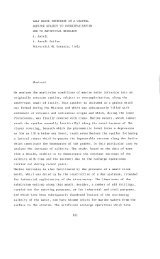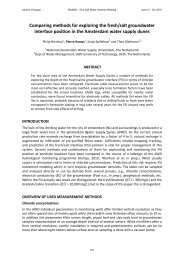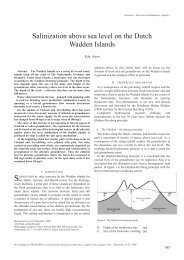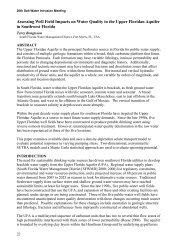F. Trabelsi, A. Ben Mammou, J. Tarhouni, C. Piga, G.P. ... - SWIM Site
F. Trabelsi, A. Ben Mammou, J. Tarhouni, C. Piga, G.P. ... - SWIM Site
F. Trabelsi, A. Ben Mammou, J. Tarhouni, C. Piga, G.P. ... - SWIM Site
You also want an ePaper? Increase the reach of your titles
YUMPU automatically turns print PDFs into web optimized ePapers that Google loves.
Salt Water intrusion characterisation in the<br />
Coastal Aquifer of Nabeul Hammamet Using<br />
Geophysical Methods<br />
(1). Fatma <strong>Trabelsi</strong> , (1). Abdallah <strong>Ben</strong> <strong>Mammou</strong>, (2) .Jamila <strong>Tarhouni</strong>, (3). Carlo <strong>Piga</strong>,<br />
(3) Gian Piero Deidda , (3). Gaetano Ranieri<br />
<br />
Abstract— A Time Domain Electromagnetic (TDEM) survey<br />
was carried out on the Mediterranean coast of Tunisia (Nabeul<br />
Hammamet), in order to delineate salt water intrusion into<br />
coastal fresh water aquifer detected by drilling wells.<br />
The survey was also carried out to determine the geometry of the<br />
fresh water aquifer and to identify the continuity between the<br />
aquifer system of Nabeul Hammamet and the contiguous aquifer<br />
system on the northern side (coastal aquifer of Korba).<br />
One dimensional interpretation of the TDEM data was<br />
correlated to existing data from borehole logs (Gamma Ray,<br />
Spontaneous Potential, Resistivity) .<br />
The results indicate that TDEM survey was able to map the<br />
interface between fresh and salt water and estimate depth to<br />
basement when siting new monitoring wells.<br />
Index Terms Coastal aquifer, Salt water intrusion, TDEM,<br />
Tunisia.<br />
I. INTRODUCTION<br />
ocated in the North -Eastern part of Tunisia in Cap Bon<br />
L peninsula, the largely populated Nabeul-Hammamet area<br />
(Figure 1) is considered an interesting agricultural sector<br />
with important urban, tourist and industrial activities. The<br />
steady increase in water consumption has severely depleted<br />
the shallow aquifer resulting in declining water levels, salt<br />
water encroachment, and dewatering in some areas of this<br />
coastal plain.<br />
The resistivity of a water bearing formation is highly<br />
dependent upon porosity, degree of saturation, and water<br />
salinity [19]. Electrical surveys may be used to map aquifers<br />
and water quality zones. The inherent capabilities of the<br />
Manuscript received September 29,2006. This work was supported in part by<br />
a cooperative ground water studies between the Faculty of Engineering of<br />
Cagliari in Italy, the National Institute of Agronomy (INAT) and a Faculty of<br />
Sciences (FST) in Tunisia, in framework of Interlink project of Italian<br />
Ministry of Research. The project is also supported by the Regional<br />
Government of Sardinia (L.R.19/96).<br />
(1). Geology Department, Faculty of Sciences of Tunis (FST), University El<br />
Manar, Tunisia (e-mail: trabelsifatma@gmail.com)<br />
(2). Genie Rural Department , National Agriculture Institute of Tunis (INAT),<br />
University 7 Novembre, Tunisia<br />
(3) Dipartimento di Ingegneria del Territorio-Università di Cagliari- Italy<br />
electrical geophysical methods to detect changes in water<br />
resistivity make them highly sensitive to the fresh-saline water<br />
interface found in coastal regions. Several authors have<br />
described the subject in detail [11, 13, 15].<br />
In the survey area, the Time Domain Electro Magnetic<br />
(TDEM) method was employed to determine electrical<br />
resistivity stratification with depth.<br />
The main aim of this work was to detect, identify and<br />
delineate aquifers by exploiting the expected large contrasts in<br />
resistivity between fresh water saturated rocks (high and<br />
intermediate resistivity) and salt water contaminated or clayey<br />
materials (low resistivity).<br />
Other aims were to verify the continuity between the aquifer<br />
of Nabeul- Hammamet and the contiguous aquifer on the<br />
northern side: the coastal aquifer of Korba. For this survey,<br />
TDEM soundings enabled to verify the presence of path-ways<br />
for migration of contaminated groundwater by salt water<br />
intrusion.<br />
Fig. 1. Location Map of Nabeul Hammamet area<br />
Proceedings 1st <strong>SWIM</strong>-SWICA Joint Saltwater Intrusion Conference, Cagliari-Chia Laguna, Italy - September 24-29, 2006<br />
Session 9 Geophysics<br />
295
Session 9 Geophysics<br />
I. GEOLOGICAL & HYDROGEOLGICAL BACKGROUND<br />
A. Geological Background<br />
Northeastern Tunisia is characterised by NE-SW to NNE-<br />
SSW folds and by faults of various directions, forming shear<br />
corridors. These faults delimit compartments with different<br />
deformation geometries [3].<br />
In the Nabeul Hammamet catchment area, is a NW-SE<br />
trending structure corresponding to the Grombalia trough<br />
covered by the Quaternary series [5]. <strong>Ben</strong>eath these series,<br />
several authors have proposed a graben structure limited by<br />
two major faults to explain the thickening of the Mio-Plio-<br />
Quaternary series in this trough [2, 6, 26]. In the southern part<br />
of the trough, the Hammamet Fault extends over a length of 5<br />
km. In the subsurface, this fault represents a major deep polyphased<br />
strike-slip fault represented by a flower structure [2, 4,<br />
6, 8, 14].<br />
This structure gives the zone a form of syncline bordered<br />
NW-wards by major faults.<br />
296<br />
Fig. 2. Structural map of Nabeul Hammamet area<br />
Fig. 3. Geological map of study area<br />
B. Hydrogeological Background<br />
The Nabeul-Hammamet area ( Figure 1) covers a surface area<br />
of about 308 km 2 , a length of 34 km and a width ranging from<br />
8 to 16 km. The climate is semi-arid with mean annual<br />
precipitation at Nabeul city of 400 mm and mean temperature<br />
of 19°C.<br />
Surface water resources are very limited. The area was<br />
supplied by two main temporary rivers (wadi) with extended<br />
catchment areas, serving to ensure natural recharge of the<br />
aquifer systems. Groundwater resources constitute the main<br />
source of water supply for agricultural, tourist and industrial<br />
activities.<br />
Former studies of the basin provided other hydrogeological<br />
information. Essentially composed of Plio-Quaternary<br />
deposits, the shallow aquifer displays several lithologies:<br />
sands, sandstones, limestones, and sandy clays. These deposits<br />
rest on the Pliocene Nabeul clay.<br />
The deeper aquifers are embedded in detritus formations of<br />
Oligo-Mio-Pliocene age.<br />
Aquifers are presumably hosted in the sedimentary formations<br />
of the Quaternary of Nabeul and in the Plio-Quaternary and<br />
Upper Oligocene of Hammamet.<br />
II. METHODS<br />
A. TDEM soundings<br />
TDEM method has been utilized successfully in<br />
hydrogeological surveys, delineating aquifers structures and<br />
contamination 13, 16, 28]. The earth is energized by abruptly<br />
shutting off the current in the transmitter. According to<br />
Faraday’s Law, currents are induced in the subsurface,<br />
decaying with time and producing secondary magnetic field<br />
that creates a measurable voltage in the receiver [27]. In the<br />
coincident loop configuration, only one loop serves as<br />
transmitter and receiver during the time-on and time-off<br />
period of the current, respectively. Unlike other geophysical<br />
sounding methods where the receiver-transmitter array must<br />
be expanded to explore deeper parts of the geoelectric section,<br />
the depth of investigation for the TDEM method depends on<br />
length of recording window [24].<br />
Measurement of the signal at later times provides information<br />
at greater depths. The intensity of the eddy currents at specific<br />
times and depths is determined by the bulk conductivity of<br />
subsurface rock units and the fluids contained therein. Depth<br />
of investigation depends on the time interval after shutoff of<br />
the primary current, because later the receiver subsequently<br />
senses eddy currents at progressively greater depths [13, 21,<br />
22]. The method is insensitive to inhomogeneities in the<br />
surface layers; most common reason for poor quality data sets<br />
in all electromagnetic methods. Among the EM methods, this<br />
method has the best lateral and vertical resolution with regards<br />
to highly conductive targets [17]. A variety of data<br />
interpretation techniques have been proposed.<br />
These include the imaging techniques [20, 30], conductive<br />
finite plate models [18, 25] and inversion methods that use 1D<br />
horizontal layered earth model [7, 9, 12, 29].<br />
A TDEM survey consists of TEM FAST 48 battery powered<br />
transmitter (4 s–16 ms), connected to a single-turn,<br />
Proceedings 1st <strong>SWIM</strong>-SWICA Joint Saltwater Intrusion Conference, Cagliari-Chia Laguna, Italy - September 24-29, 2006
ungrounded, insulated cable in the form of a square loop with<br />
sides of between 25 and 300m.<br />
In the present work, we conducted a large scale TDEM<br />
survey involving 55 soundings (Figure 4) with the coincident<br />
loop configuration (50×50m and 100 ×100m square loops at<br />
respectively 50m and 100m spacing) aligned on a rectangular<br />
grid. We performed 1D interpretation scheme [10] and the<br />
interpreted results have been correlated with availabe<br />
geological and geophysical data, providing useful information<br />
about the local hydrogeological conditions.<br />
Fig. 4. Location of TDEM stations in the study area<br />
III. RESULTS<br />
A. TDEM Results<br />
Time Domain Electromagnetic (TDEM) soundings were<br />
interpreted using one-dimensional (1-D) inversion. The initial<br />
model for each inversion was obtained by first applying<br />
Occam’s inversion [9] and then reducing to the minimum<br />
possible the number of layers in the recovered smooth model.<br />
Most of the sites yield sounding curves with a monotonic<br />
decrease in apparent resistivity with time. Such curve behavior<br />
undoubtedly proves the presence of a low resistivity layer in<br />
the base of the section. At some sites it was necessary to<br />
include a thin layer of very low resistivity within the top<br />
resistive layer to be consistent with the data.<br />
Figure 5 shows some typical examples of TDEM sounding<br />
curves from locations close to the coast (sites F16 and F15)<br />
and farther inland (sites F12, F13, F7, F6, F3, F8 and F9). The<br />
quantitative interpretation of the TDEM measurements is,<br />
however hampered by the equivalence problem, which means<br />
that several different layered models may give practically the<br />
same resistivity curve.<br />
To choose the model that best represents actual subsurface<br />
conditions, supplementary data such as well logs are required.<br />
In the study area there are more than 200 drilled wells. The<br />
static water level is generally found at a few meters above<br />
mean sea level.<br />
Fig. 5. Examples of model of resistivity vs. depth generated by TEM- FAST<br />
smooth modelling procedure corrected to sea level<br />
1) Comparison of borehole Log and TDEM resistivity<br />
Both TDEM soundings from the surface and borehole<br />
resistivity logs measure vertical geoelectrical sections.<br />
Comparison of the two provides important information (i) to<br />
define the position of the transition zones within individual<br />
coastal plain aquifers, (ii) to interpret the geoelectrical section<br />
derived from TDEM data.<br />
We present results of TDEM, which are correlated to borehole<br />
logs (SP, GR, and Resistivity). TDEM soundings were<br />
conducted at existing drilled wells wherever possible, or at a<br />
maximum distance of 1km from wells allowing correlation of<br />
apparent resistivity with borehole geophysical logs. TDEM<br />
survey can then be extrapolated to other parts of the coastal<br />
plain between research stations.<br />
The TDEM resistivity soundings show good correlation with<br />
the borehole resistivity, SP and GR Logs. The sequence and<br />
thickness of layers, however, and the relative values of high<br />
and low resistivity, are consistent between two records.<br />
Field example 1<br />
The presence of dispersed or interbedded clay will suppress<br />
the bulk resistivity of an aquifer, as shown by the example in<br />
Figure 6 where the relatively high Gamma Ray count in the<br />
borehole log reflects the clay-rich nature of the aquifer in this<br />
area. Low resistivity measurements on both the TDEM<br />
sounding and borehole resistivity log represent the combined<br />
effects of clay content and high salinity conditions within the<br />
aquifer.<br />
Proceedings 1st <strong>SWIM</strong>-SWICA Joint Saltwater Intrusion Conference, Cagliari-Chia Laguna, Italy - September 24-29, 2006<br />
Session 9 Geophysics<br />
297
Session 9 Geophysics<br />
Fig. 6. Field Example 1<br />
Field Example 2<br />
In this example (Figure 7), the TDEM sounding shows good<br />
correlation with the borehole log. The depth of the low<br />
resistivity layer coincides with a water level of the borehole<br />
(-9.5m) which is considered as the fresh water aquifer.<br />
The second low resistivity zone is apparent below the depth of<br />
(-6m) with very low resistivity. This layer consists of<br />
sandstone with clay and is attributed to the saline water<br />
infiltration. Additional TDEM surveys in the study area<br />
indicate that up coning of salt water may be occurring due to<br />
excessive withdrawals from local supply wells.<br />
298<br />
Fig. 7. Field example 2<br />
2) Geoelectrical sections 2D<br />
On the basis of the geological and geophysical data of<br />
hydrogeological drillings and oil wells, and the results of<br />
correlation between borehole logs and TDEM resistivity<br />
soundings, the aquifer system of Nabeul Hammamet is<br />
considered as a multi-layer aquifer..<br />
In order to understand the distribution of the permeable area,<br />
the geoelectrical sections have been constructed.<br />
Proceedings 1st <strong>SWIM</strong>-SWICA Joint Saltwater Intrusion Conference, Cagliari-Chia Laguna, Italy - September 24-29, 2006
The section contributes (i) to defining the geometry of the<br />
aquifer, in particular in the northeastern part of Nabeul, (ii) to<br />
identifying the structures and (iii) a salt water wedge.<br />
Geoelectrical models plotted in pseudo 2-D sections, using<br />
interpolation to acquire a better presentation of the subsurface<br />
of the area, shows the presence of three aquifers formation.<br />
In Figure 8, the geoelectrical section (1) obtained, shows a<br />
very low resistivity layer between 1-5 Ohm-m attributed to<br />
aquifer formation at greater depths, primarily due to salt water<br />
encroachment.<br />
In the near surface down to depths of over 20m, exists a layer<br />
formation with a resistivity between 7-20 Ohm-m, indicative<br />
of fresh water. It coincides with a thick high resistivity zone<br />
on the borehole record.<br />
But in some geoelectrical sections, a high resistivity layer with<br />
25-55 Ohm-m indicative of fresh water in the shallower<br />
aquifers, is readily apparent near the surface. It coincides with<br />
a thick high -resistivity zone on the borehole record. This high<br />
resistivity zone just appears in the TDEM sounding in fault<br />
zones. This variation of resistivity correlated to structural data<br />
gives good agreement for the presence of these faults and<br />
graben boundary definition. TDEM sounding within the<br />
graben shows continuity of the aquifer formation overlain by<br />
thin sediments.<br />
On the other hand hydrostratigraphic details are almost<br />
completely masked by a low resistivity contrast between fresh<br />
water aquifers and clays and by the lateral effect of fault<br />
displacements in this areas. Consequently, this fresh aquifer<br />
cannot be detected due to lack of resolution.<br />
Fig. 8 . Geoelectrical section (1)<br />
Fresh water, salt water transition zones and the geometry of<br />
the salt wedge in the aquifer are shown in the geoelectrical<br />
sections by vertical and lateral variations in resistivity within<br />
individual aquifers. The geoelectrical section of lateral profile<br />
(Figure 9) parallel to the coast shows a very low resistivity<br />
layer, according to the well log.<br />
The top layer consists of an aquifer formation, hence, the<br />
low resistivity is attributed to the saline water infiltration.<br />
Fig. 9. Geoelectrical section (2)<br />
The question always asked by hydrogeologists about the<br />
Nabeul Hammamet aquifer, is whether continuity and<br />
communication exists within this aquifer and the contiguous<br />
aquifer on the northern-eastern side (coastal aquifer of Korba).<br />
A cross section (Figure 10), shows continuity of the two<br />
aquifers and probably the presence of fault detected in<br />
sounding b5, interpreted as the limit of this aquifer.<br />
Fig. 10. Geoelectrical Section (3)<br />
3) 3D geoelectrical section<br />
A 3D model was constructed using EVS (Environmental<br />
Visualisation Software) data representation.<br />
The program is able to extract data from the entire volume<br />
investigated (i.e. resistivities higher, lower than fixed value)<br />
and reconstruct by a 3D interpolation, the plume or the<br />
extension of a layer in the volume.<br />
Proceedings 1st <strong>SWIM</strong>-SWICA Joint Saltwater Intrusion Conference, Cagliari-Chia Laguna, Italy - September 24-29, 2006<br />
Session 9 Geophysics<br />
299
Session 9 Geophysics<br />
Fig.11. 3-D Model of resistivity layer between 1 and 5 Ohm-m<br />
Figure 11 shows the plume of a resistivity layer ranging<br />
from 1-5 Ohm-m. Comparison between the results of TDEM<br />
soundings, borehole logs and 2-D geoelectrical sections,<br />
shows that for the TDEM soundings near the coast, this layer<br />
can be attributed to salt water intrusion. For the TDEM<br />
soundings carried out in inland areas this low resistivity can<br />
be attributed to salt clay deposits and it can be due to intensive<br />
pumping from wells in the area.<br />
Figure 12 shows the continuity of resistivity layer ranging<br />
between 7 and 25 Ohm-m versus elevation. This layer is<br />
attributed to the second aquifer formation, and confirms<br />
results of the geoelectrical section (3).<br />
In general, these interpretation results are a good agreement<br />
with the expected resistivity values for the layers appearing in<br />
the well log, and the 2-D sections.<br />
300<br />
Fig.12. 3-D Model of resistivity layer between 7 and 25 Ohm-m<br />
IV. CONCLUSION<br />
TDEM surveys provide an efficient, and semi-quantitative<br />
method of evaluating ground water resources in coastal<br />
aquifers, at fairly high vertical resolution, to a depth down to<br />
few hundred meters, on both local and regional scales.<br />
Comparison between TDEM soundings and borehole logs<br />
provides more information about fresh water formation and<br />
the structural configuration of the aquifer.<br />
In our work, we delineate the salt water intrusion areas,<br />
identify a subsurface aquifer formation and determine the<br />
hydrogeological limit between the Korba and Nabeul-<br />
Hammamet aquifers.<br />
ACKNOWLEDGMENT<br />
This work was conducted as part of cooperative ground water<br />
studies between the Faculty of Engineering at Cagliari<br />
University in Italy, the National Institute of Agronomy<br />
(INAT) and the Faculty of Sciences of Tunis (FST). “F. A.<br />
Fatma <strong>Trabelsi</strong> thanks all the research team at the geophysics<br />
laboratory at the Faculty of Engineering at Cagliari University<br />
(Italy).<br />
[1]<br />
REFERENCES<br />
R. <strong>Ben</strong>i Akhy. Etude des impacts anthropiques sur les eaux souterraines<br />
du sahel oriental tunisien : Caractérisation hydrogéologique,<br />
modélisation mathématique et cartographie de la vulnérabilité<br />
[2]<br />
environnementale. Thèse de doctorat. Géologie. Fac. Sc. Tunis. 377 p,<br />
1998.<br />
N. <strong>Ben</strong> Ayed, “ Evolution tectonique de l’avant-pays de la chaîne alpine<br />
de la Tunisie du début du Mésozoïque à l’Actuel ”. Thèse d’Etat,<br />
université Paris-11, Orsay, Publ. Office Nat. Mines Tunis, 1993.<br />
[3] M. <strong>Ben</strong> Haj Ali, Y. Jedoui, T. Dali, H. <strong>Ben</strong> Salem, L. Memmi. “<br />
Carte géologique à l’échelle 1 :500 000 de la Tunisie”, Serv. Geol.<br />
Tunisie, 1985.<br />
[4] H. <strong>Ben</strong> Salem., “Contribution à la connaissance de la géologie du Cap<br />
Bon: Stratigraphie, Tectonique et Sédimentologie”. Thèse 3 ème cycle<br />
Faculté des Sciences de Tunis Université de Tunis II. 144p, 1992.<br />
[5] G. Castany, “Les fossés d’effondrement de Tunisie”. Ann. Min. Geol.<br />
Tunis 3 (1948).<br />
[6] L. Chihi, “Les fossés néogènes à quaternaire de la Tunisie et de la mer<br />
pélagienne : une étude structurale et une signification dans le cadre<br />
géodynamique de la Méditerranée centrale”. Doctorat d’Etat. Univ de<br />
Tunis II. Fac. Sc. Tunis. 324p, 1995.<br />
[7] N.B.Christensen,“Imaging and inversion of transient electromagnetic<br />
soundings. In: EEGS Proc. Symp. Application of Geophysics to<br />
Engineering and Environmental Problems”, Orlando, April 1995 ; pp.<br />
511-517, 1995.<br />
[8] B. Colleuil, “Etude stratigraphique et néotectonique des formations<br />
néogènes et quaternaires de la région de Nabeul Hammamet (Cap Bon<br />
Tunisie) ”. Mém. DES, faculté des sciences et techniques, Nice, 1976.<br />
[9] S . Constable., R. Parker, C . Constable,“Occam’s inversion. A practical<br />
algorithm for generating smooth models from electromagnetic sounding<br />
data”. Geophysics . v. 52, no. 3, pp.289-300, 1987.<br />
[10] E. Fainberg, “TEM FAST 48 manual, AEMR”, 1999.<br />
[11] DV. Fitterman, “ Examples of transient sounding for groundwater<br />
exploration in sedimentary aquifers”. Ground Water 25, 685-692,1987.<br />
[12] M .Goldman, “Transient electromagnetic inversion based on an<br />
approximate solution to the forward problem”, Geophysics, 53, 118-128,<br />
1988.<br />
[13] M .Goldman , D. Gilad, A. Melloul, “Mapping of sea water intrusion<br />
into the coastal aquifer of Israel by the time domain electromagnetic<br />
method. Geoexploration”,v.28, pp.153-174,1991.<br />
[14] M. Hadj Sassi, H. Zouari, “Contribution de la gravimétrie et de la<br />
sismique réflexion pour une nouvelle interprétation géodynamique des<br />
Proceedings 1st <strong>SWIM</strong>-SWICA Joint Saltwater Intrusion Conference, Cagliari-Chia Laguna, Italy - September 24-29, 2006
fossés d’effondrement en Tunisie: exemple du fossé de Grombalia”,<br />
C.R. Geoscience, 338, 751-756, 2006.<br />
[15] J.R.T. Hazell, C.R. Cratchley, A.M. Preston, “The location of aquifers in<br />
crystalline rocks and alluvium in northern Nigeria using combined<br />
electromagnetic and resistivity techniques”. Q.J. Eng. Geol.21, 159-175,<br />
1988.<br />
[16] P. Hoekstra, M. Bloom, “Case histories of time domain electromagnetic<br />
soundings in environmental geophysics”. In : Ward, S. (Ed.),<br />
Geotechnical and Environmental Geophysics, vol.2. SEG, Tulsa, OK,<br />
pp.1-15,1986.<br />
[17] A.A. Kaufman , and G.V. Keller, “Frequency and Transient Soundings”.<br />
Elsevier, Amsterdam, 1983.<br />
[18] P.B. Keating, and D J. Crossley, “The inversion of time-domain<br />
electromagnetic data using the finite plate model”. Geophysics, 55, 705-<br />
711, 1990.<br />
[19]<br />
[20] G.V. Keller and F.C. Frischknecht, “Electrical Methods in Geophysical<br />
Prospecting”. Pergamon, NY, 1966.<br />
[21] T. Lee, “Estimation of depth to conductors bye the use of<br />
electromagnetics transients”. Geophys: Prosp., 25, 61-75, 1977.<br />
[22] J.D. McNeill, “Use of electromagnetic methods for groundwater<br />
studies”. Geotechnical and Environmental Geophysics, vol. 1. SEG,<br />
Tulsa, Oklahoma, pp. 191-218, 1990.<br />
[23] T. Mills, P.Hoekstra, M. Bloom, and L. Evans, “Time Domain<br />
Electromagnetic soundings for mapping sea-water intrusion in Monterey<br />
County, Clifornia”. Ground Water 26, 771-782, 1988.<br />
[24] H. Mzali, H. Zouari, “Evidence of N120 shear corridors and associated<br />
tectonic structures in northeastern Tunisia after geological and<br />
geophysical data”, C.R. Geoscience, 339, 358-365, 2007.<br />
[25] M.N. Nabighian, “Quasistatic transcient response of a conducting halfspace.<br />
An approximate representation”, Geophysics, 44, 1700-1705,<br />
1979.<br />
[26] M. Pirttijarvi,., S.K. Verma,., S. Hjelt, “Inversion of transient<br />
electromagnetic profile data using conductive finite plate model”. J.<br />
Appl. Geophys., 38. 181-194, 1998.<br />
[27] M.M. Turki, “Poly cinématique et contrôle sédimentaire associé sur la<br />
cicatrice de Zahouan-Nebhana”. Thèse d’Etat, faculté des sciences de<br />
Tunis, 1985.<br />
[28] A.P. Raiche, “The effect of ramp function turn-off on the TEM response<br />
of a layered ground”. Explor.Geophys. 15, 37-41, 1984.<br />
[29] G. Ranieri, “Tem Fast: a useful tool for hydrogeologists and<br />
environmental engineers”. Annali Di Geophysica, Vol.43,N.6,, 1147-<br />
1158, 2000.<br />
[30] R.S. Smith, R.N. Edwards, and G . Buselli, “An automatic technique for<br />
presentation of coincident-loop, impulse-response, transient,<br />
electromagnetic data”, Geophysics, 59, 1542-1550, 1994.<br />
[31] Tartaras, E., and Zhdanov, M.S, “Fast S-inversion in the time domain:<br />
method of interpretation using the thin sheet approach”, 66 th Ann. Int.<br />
Mtg., Soc. Expl. Geophys., Expanded Abstracts, 1306-1309, 1996.<br />
Proceedings 1st <strong>SWIM</strong>-SWICA Joint Saltwater Intrusion Conference, Cagliari-Chia Laguna, Italy - September 24-29, 2006<br />
Session 9 Geophysics<br />
301
Session 9 Geophysics<br />
302<br />
Proceedings 1st <strong>SWIM</strong>-SWICA Joint Saltwater Intrusion Conference, Cagliari-Chia Laguna, Italy - September 24-29, 2006

















